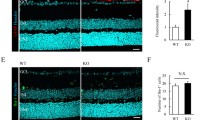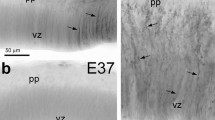Summary
-
1.
In the nervous system, Glial fibrillary acidic protein (GFAP) is a well-known, cell type-specific marker for astrocytes.
-
2.
In the mammalian retina, Muller cells, the major class of retinal glia, do not express GFAP or contain only low amounts of this protein. In retinas with photoreceptor degeneration, however, high levels of GFAP are found. It is possible that GFAP synthesis in these retinas could result from “dedifferentiation” of Muller cells as a consequence of disruption of normal neuron-glia interactions.
-
3.
We have carried out immunocytochemical andin situ hybridization studies to examine whether GFAP or its mRNA is expressed by retinal cells early in embryonic development.
-
4.
Our results show that GFAP-containing cells, which are probably astrocytes, are found only in the ganglion cell and nerve fiber layers and that these cells appear after postnatal day-1 (P-1) and continue to form until P-10.
-
5.
Astrocyte formation starts from the optic disc and moves toward the periphery of the retina at a rate of ~ 160–200µm per day.
-
6.
An unexpected result from these studies is that GFAP mRNA levels are high in the first week of birth and decline rapidly as the animal develops.
-
7.
Finally, we did not find either GFAP or GFAP mRNA in retinal cells other than astrocytes during normal development.
Similar content being viewed by others
References
Baker, B. J., and Perry, V. H. (1985). The effect of ganglion cell depletion on the development of astrocytes and the blood vessel distribution in the retina.Neurosci. Lett. (Suppl.)2168.
Balcarek, J. M., and Cowan, N. J. (1985). Structure of the mouse glial fibrillary acidic protein gene: Implications for the evolution of the intermediate filament multigene family.Nucl. Res. 135527–5543.
Bernier, L., Colman, D. R., and D'Eustachio, P. (1988). Chromosomal locations of genes encoding 2′,3′ cyclic nucleotide 3′-phosphodiesterase and glial fibrillary acidic protein in the mouse.J. Neurosci. Res. 20497–504.
Bignami, A., and Dahl, D. (1979). The radial glia of Müller in the rat retina and their response to injury. An immunofluorescence study with antibodies to the glial fibrillary acidic (GFA) protein.Exp. Eye Res. 2863–69.
Bignami, A., Eng, L. F., Dahl, D., and Uyeda, C. T. (1972). Localization of the glial fibrillary acidic protein in astrocytes by immunofluorescence.Brain Res. 43429–435.
Bignami, A., Dahl, D., and Rueger, D. G. (1980). Glial fibrillary acidic (GFA) protein in normal neural cells and in pathological conditions.Adv. Cell. Neurobiol. 1285–310.
Bjorklund, H., Bignami, A., and Dahl, D. (1985). Immunohistochemical demonstration of glial fibrillary acidic protein in normal rat Müller glia and retinal astrocytes.Neurosci. Lett. 54363–368.
Blanks, J. C., and Bok, D. (1977) An autoradiographic analysis of postnatal cell proliferation in the normal and degenerative mouse retina.J. Comp. Neurol. 174317–328.
Bologa, L., Cole, R., Chiappelli, F., Saneto, R. P., and De Vellis, J. (1988). Expression of glial fibrillary acidic protein by differentiated astrocytes is regulated by serum antagonistic factors.Brain Res. 457295–302.
Brahic, M., and Haase, A. T. (1978). Detection of viral sequences of low reiteration frequency by in situ hybridization.Proc. Natl. Acad. Sci. USA 49957–1003.
Bromberg, J. S., and Schachner, M. (1978). Localization of nervous system antigens in retina by immunohistology.Invest. Ophthal. Vis. Sci. 17920–924.
Charriere-Bertrand, C., LePrince, G., Bouchier, C., Fages, C., Tardy, M., and Nunez, J. (1989). Expression of tubulin, GFAP and of their encoding mRNAs during the proliferation and differentiation of cultured astrocytes.Neurochem. Int. 15215–222.
Dixon, R. G., and Eng, L. F. (1981). Glial fibrillary acidic protein in the retina of the developing albino rat: an immunoperoxidase study of paraffin embedded tissue.J. Comp. Neurol. 195305–322.
Drager, U. C., and Edwards, D. L. (1983). Antibodies to intermediate filaments reveal abnormalities in retinas of mice with photoreceptor degeneration.Invest. Ophthalmol. Vis. Sci. 24115.
Eckstrom, P., Sanyal, S., Narfstrom, K., Chader, G. J., and Van Veen, T. (1988). Accumulation of glial fibrillary acidic protein during retinal degeneration.Invest. Ophthalmol. Vis. Sci. 291363–1371.
Eisenfeld, A. J., Bunt-Milam, A., and Sarthy, P. V. (1984). Müller cell expression of glial fibrillary acidic protein after genetic and experimental photoreceptor degeneration in the rat retina.Invest. Ophthalmol. Vis. Sci. 251321–1328.
Eisenfeld, A. J., Bunt-Milam, A. H., and Saari, J. C. (1987). Uveoretinitis in rabbits following immunization with interphotoreceptor retinoid-binding protein.Exp. Eye Res. 44425–438.
Eng, L. F., and DeArmond, S. J. (1982). Immunocytochemical studies of astrocytes in normal development and diseases.Adv. Cell. Neurobiol. 3145–171.
Eng, L. F., Vanderhaeghen, J. J., Bignami, A., and Gerstl, B. (1971). An acidic protein isolated from fibrous astrocytes.Brain Res. 28351–354.
Erickson, P. A., Fisher, S. K., Guerin, C. J., Anderson, D. H., and Kaska, D. D. (1987). Glial fibrillary acidic protein increases in Müller cells after retinal detachment.Exp. Eye Res. 4437–48.
Freeman, M. R., Beckmann, S. L., and Sueoka, N. (1989). Regulation of the S100 protein and GFAP genes is mediated by two common mechanisms in RT4 neuro-glial cell lines.Exp. Cell Res. 182370–383.
Gaur, V. P., Adamus, G., Arendt, A., Eldred, W., Possin, D. E., McDowell, J. H., Hargrave, P., and Sarthy, P. V. (1988a). A monoclonal antibody that binds to photoreceptors in the turtle retina.Vis. Res. 28765–776.
Gaur, V. P., Eldred, W., and Sarthy, P. V. (1988b). Distribution of Muller cells in the turtle retina: An immunocytochemical study.J. Neurocytol. 17683–692.
Harper, M. E., Marselle, L. M., Gallo, R. C., and Wong-Staal, F. (1986). Detection of lymphocytes expressing human T-lymphotropic virus type III in lymph nodes and peripheral blood from infected individuals by in situ hybridization.Proc. Natl. Acad. Sci. USA 83772–776.
Karschin, A., Wassle, H., and Schnitzer, J. (1986). Shape and distribution of astrocytes in the cat retina.Invest. Ophthalmol. Vis. Sci. 27828–831.
Kuwabara, T. (1975). Development of the optic nerve of the rat.Invest. Ophthalmol. 14732–745.
Landry, C. F., Ivy, G. O., and Brown, I. R. (1990). Developmental expression of glial fibrillary acidic protein mRNA in the rat brain analyzed by in situ hybridization.J. Neurosci. Res. 25194–203.
Lawrence, J. B., and Singer, R. H. (1985). Quantitative analysis of in situ hybridization methods for the detection of actin gene expression.Nucleic Acids Res. 131777–1799.
Levitt, P., Cooper, M. L., and Rakic, P. (1981). Co-existence of neuronal and glial precursor cells in the cerebral ventricular zone of the fetal monkey: An ultrastructural immunoperoxidase analysis.J. Neurosci. 127–39.
Lewis, S. A., and Cowan, N. J. (1985). Temporal expression of mouse glial fibrillary acidic protein mRNA studied by a rapid in situ hybridization procedure.J. Neurochem. 45913–919.
Lewis, S. A., Balcarek, J. M., Krek, V., Shelanski, M., and Cowan, N. J. (1984). Sequence of a cDNA clone encoding mouse glial fibrillary acidic protein: Structural conservation of intermediate filaments.Proc. Natl. Acad. Sci. USA 812743–2746.
Ling, T., and Stone, J. (1988). The development of astrocytes in the cat retina: Evidence of migration from the optic nerve.Dev. Brain Res. 4473–85.
Ling, T., Halasz, P., and Stone, J. (1988a). Factors determining the distribution of astrocytes in the mammalian retina.Neurosci. Lett. 28(Suppl.):S91.
Ling, T., Mistrofanis, J., and Stone, J. (1988b). The spread of GFAP-positive astrocytes in the developing rat retina.Neurosci. Lett. 28(Suppl):S92.
Malloch, G. D. A., Clark, J. B., and Burnet, F. R. (1987). Glial fibrillary acidic protein in the cytoskeletal and soluble protein fraction of the developing rat brain.J. Neurochem. 48299–306.
Maniatis, T., Fritisch, E. F., and Sambrook, J. (1982).Molecular Cloning: A Laboratory Manual, Cold Spring Harbor Laboratory, Cold Spring Harbor, N.Y.
Miller, N. M., and Oberdorfer, M. (1981). Neuronal and neuroglial responses following retinal lesions in the neonatal rats.J. Comp. Neurol. 202493–504.
Mokuno, K., Kamholz, J., Behrman, T., Black, C., Sessa, M., Feinstein, D., Lee, V., and Pleasure, D. (1989). Neuronal modulation of Schwann cell glial fibrillary acidic protein (GFAP).J. Neurosci. Res. 23396–405.
Molnar, M. L., Stefansson, K., Marton, L. S., Tripathi, R. C., and Molnar, G. K. (1984). Distribution of S-100 protein and glial fibrillary acidic protein in normal and gliotic human retina.Exp. Eye Res. 3827–34.
Morrison, R. S., De Vellis, J., Lee, Y. L., Bradshaw, R. A., and Eng, L. F. (1985). Hormones and growth factors induce the synthesis of glial fibrillary acidic protein in rat brain astrocytes.J. Neurosci. Res. 14167–176.
Moscona, A. A., and Linser, P. (1983). Developmental and experimental changes in retinal glial cells: Cell interactions and control of phenotype expression and stability.Curr. Top. Dev. Biol. 18155–188.
Okada, T. S. (1981). Cellular metaplasia or transdifferentation as a model for retinal cell differentiation.Curr. Top. Dev Biol. 16349–380.
Reichenbach, A., and Wohlrab, F. (1986). Morphometric parameters of Muller (glial) cells dependent on their topographic localization in the nonmyelinated part of the rabbit retina; A consideration of functional aspects of radial glia.J. Neurocytol. 15451–459.
Ripps, H., and Witkovsky, P. (1985). Neuron-glia interaction in the brain and retina.Prog. Ret. Res. 4181–219.
Sanyal, S., and Bhattarjee, J. (1979). Autoradiographic study of the early development of retina Muller cells in mice.Ophthal. Res. 11216.
Sarthy, P. V., and Bacon, W. D. (1985). Developmental expression of a synaptic vesicle-associated protein in the rat retina.Dev. Biol. 112284–291.
Sarthy, P. V., and Fu, M. (1989). Transcriptional activation of an intermediate filament protein gene in mice with retinal dystrophy.DNA 8437–446.
Schnitzer, J. (1985). Distribution and immunoreactivity of glia in the retina of the rabbit.J. Comp. Neurol. 240128–142.
Schnitzer, J. (1987a). Retinal astrocytes: Their restriction to vascularized parts of the mammalian retina.Neurosci. Lett. 7829–32.
Schnitzer, J. (1987b). Astrocytes in mammalian retina.Prog. Ret. Res. 7209–231.
Schnitzer, J. (1988a). Astrocytes in the guinea pig, horse and monkey retina: Their occurrence coincides with the presence of blood vessels.Glia 174–89.
Schnitzer, J. (1988b). Immunocytochemical studies on the development of astrocytes, Muller (glial) cells, and oligodendrocytes in the rabbit retina.Dev. Brain Res. 4459–72.
Schnitzer, J. (1988c). The development of astrocytes and blood vessels in the postnatal rabbit retina.J. Neurocytol. 17433–449.
Schnitzer, J., Franke, W. W., and Schachner, M. (1981). Immunocytochemical demonstration of vimentin in astrocytes and ependymal cells of the developing and adult mouse nervous system.J. Cell Biol. 90435–447.
Sharpe, G. A., Osborn, M., and Weber, K. (1982). Occurrence of two different intermediate filament proteins in the same filament in situ within a human cell line.Exp. Cell Res. 141385–396.
Shaw, G., and Weber, K. (1983). The structure and development of the rat retina: An immunofluorescence microscopical study using antibodies specific for intermediate filament proteins.Eur. J. Cell Biol. 30219–232.
Sigelman, J., and Ozanics, V. (1982). Retina. InBiomedical Foundations of Ophthalmology.Vol. 1 (W. Tasman and E. A. Jaeger, Ed.), J. B. Lippincott, Philadelphia, pp. 1–66.
Stone, J., and Dreher, Z. (1987). Relationship between astrocytes, ganglion cells and vasculature of the retina.J. Comp. Neurol. 25535–49.
Tardy, M., Fages, C., Riol, H., LePrince, G., Rataboul, P., Charriere-Bertrand, C., and Nunez, J. (1989). Developmental expression of the glial fibrillary acidic protein in the central nervous system and in cultured astrocytes.J. Neurochem. 52162–167.
Turner, D. L., and Cepko, C. L. (1987). A common progenitor for neurons and glia persists in rat retina late in development.Nature 328131–136.
Watanabe, T., and Raff, M. C. (1988). Retinal astrocytes are immigrants from the optic nerve.Nature 332834–937.
Young (1985). Cell differentiation in the retina of the mouse.Anat. Rec. 212199–205.
Author information
Authors and Affiliations
Rights and permissions
About this article
Cite this article
Sarthy, P.V., Fu, M. & Huang, J. Developmental expression of the Glial fibrillary acidic protein (GFAP) gene in the mouse retina. Cell Mol Neurobiol 11, 623–637 (1991). https://doi.org/10.1007/BF00741450
Received:
Accepted:
Issue Date:
DOI: https://doi.org/10.1007/BF00741450




